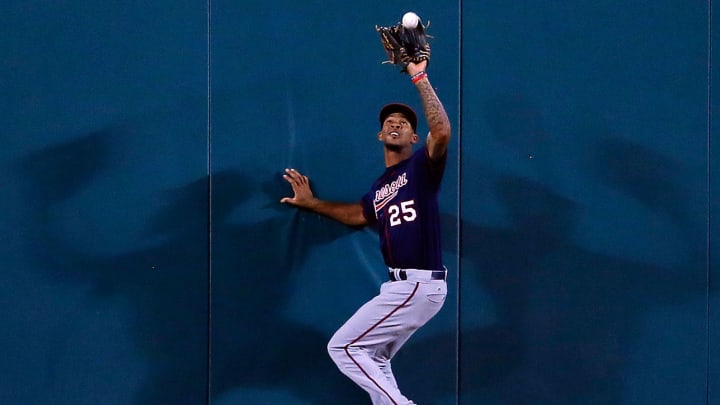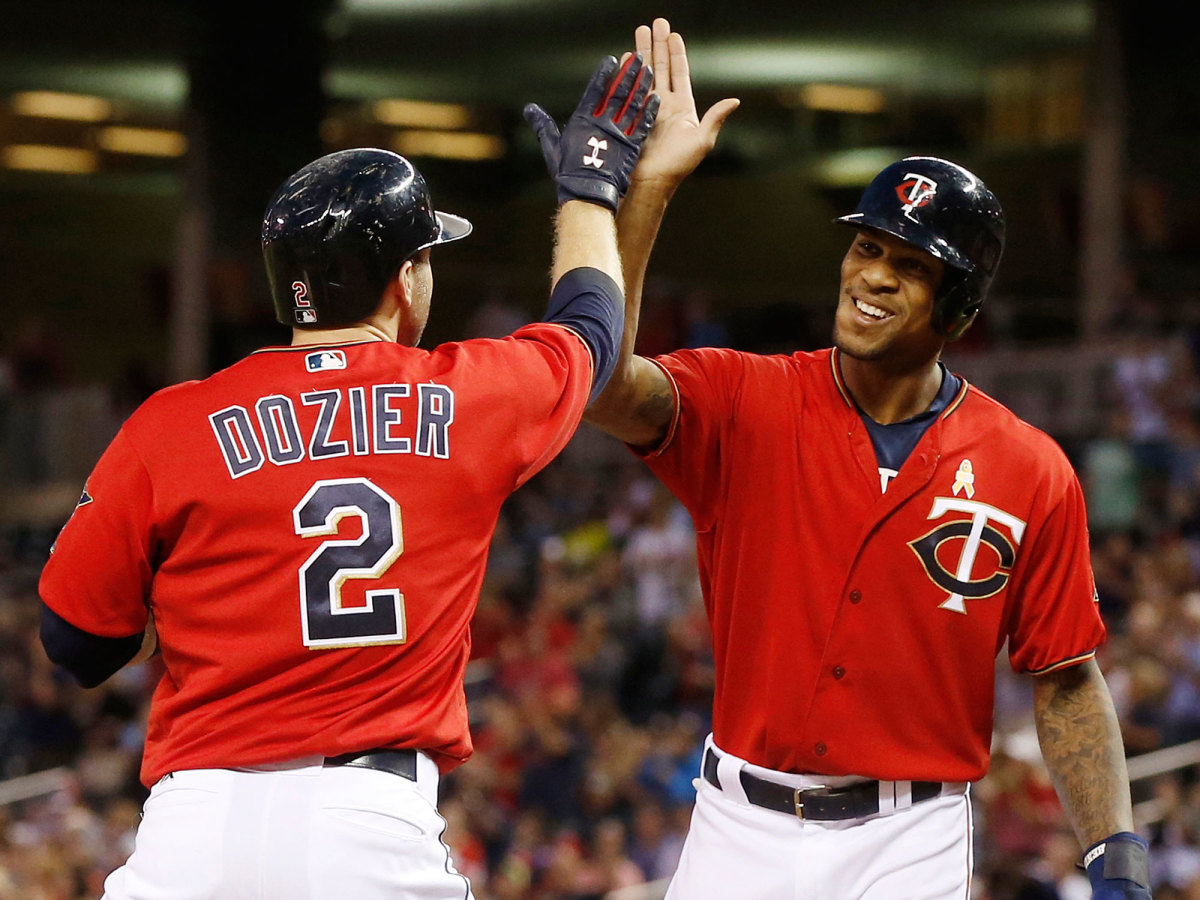Brian and Byron Plan: Dozier and Buxton just two reasons Twins have hope

Optimism does not usually course through the clubhouses of teams that are 36 games below .500, the losers of 17 of their last 20 games and just weeks away from ending their fifth season of 90 or more losses in the past six years. To be fair, the Minnesota Twins are probably not feeling particularly good about themselves at the moment. They are not just baseball’s worst team—at 52-88 through Wednesday, they are two games beneath the Atlanta Braves, who were not at all designed to win this season—but arguably its most disappointing. Their surprising wild card contention and 83-79 finish in 2015, under rookie manager Paul Molitor, seemed to portend positive things in the near term. It did not.
Even so, if you carefully peer through a magnifying glass, in good light, you can detect a route by which the club might soon again become the postseason fixture that it was not so long ago, and the possibility that 2016 will come to represent a mortifying detour. Most of it involves an offense that has been quite productive—11th in the majors in runs scored—despite the presence of periodically underperforming players up and down the lineup.
One player who has not underperformed, by any stretch, is second baseman Brian Dozier. Not that many outside Minnesota have noticed, due to the Twins’ curdled putrescence, but the 29-year-old has transformed himself from a guy with good power for his position to one of the game’s best sluggers. Dozier hit his 39th home run of the season in another loss on Tuesday night—his ninth in his last seven games—and he now has more than anyone in baseball except the Orioles’ Mark Trumbo. Since the All-Star break, Dozier has slugged an astounding 24 homers, eight more than anyone else, and his .929 OPS for the season ranks fifth in baseball, sandwiched between Miguel Cabrera and Manny Machado. Thanks to the four-year, $20 million extension he signed in March of 2015, the Twins will have to pay him just $15 million combined over the next two years. A legitimate MVP candidate at that price represents a good asset with which to start any turnaround.
Inside Brian Dozier's incredible power surge and his quest for a home run record
Dozier, remarkably, has in the second half accumulated twice as many total bases as any of his teammates, and he accounts for 21% of his club’s total bases over that stretch. Still, several of his younger teammates have been demonstrating the promise that marked them as foundational talents. Max Kepler and Miguel Sano have each slugged eight homers since the break; both stand 6’4”, and both are just 23 years old. Eddie Rosario, a former top prospect whose horrific start led to his demotion in mid-May, has rebounded to hit .291 with four homers since the break; he is just 24.
Even more encouraging has been the recent play of the perennially disappointing Byron Buxton. Buxton was the second overall pick out of Appling County (Ga.) High in the 2012 draft—behind only Houston's Carlos Correa, whose $4.8 million signing bonus he exceeded by $1.2 million—and he has been ranked as the game’s No. 1 or No. 2 prospect in every season since 2014. But whether the fault lies with his lingering injuries, the Twins’ developmental system or Buxton himself, the fact was that despite raking in the minors, the electrically athletic centerfielder didn't produce whenever he periodically reached Minnesota. As recently as Aug. 31, after 109 big league games, Buxton had a career batting average of .199 with three homers and 22 RBIs.

However, in seven games since coming back up on Sept. 1, the 22-year-old Buxton has hit four home runs, driven in 10 runs and batted .462/.481/1.077. No matter what Dozier does from here on out, September of 2016 might come to be remembered as the month in which the Byron Buxton era finally began.
Alas, there have been many fewer signs of life from the group that has plagued the Twins since they won their sixth division title in nine years in 2010: the pitching staff. Through Tuesday, Minnesota ranked last in the majors in ERA, at a miserable 5.20, but even more alarming was its cumulative OPS against, .819. There are many ways to quantify just how atrocious this number is—it is the worst for any club in the past four years—but here is an illustrative one: the two individual players who as of that day had an OPS of exactly .819 were Indians shortstop Francisco Lindor and Pirates outfielder Starling Marte. Lindor and Marte were both All-Stars this year. The Twins’ pitchers have essentially turned every hitter they have faced this season, on average, into an All-Star. There is simply no possibility of winning when that happens.
The team's pitching problem is certainly no secret to the front office, but Minnesota does not have the financial wherewithal to compete for the best free agents, and has therefore resorted to overpaying the middling ones. With the exception of Ervin Santana—the rotation’s lone bright spot this year, as he has a 3.58 ERA in the second season of a four-year, $55 million deal—this strategy has not worked out. It has resulted in such misfires as:
• Four years and $49 million for Ricky Nolasco. He put up a 5.44 ERA in two and a half seasons with the Twins and was traded to the Angels at the Aug. 1 deadline.
• A total of three years and $15 million for Mike Pelfrey. He posted a 4.94 ERA with the Twins and signed with the Tigers last off-season.
• Three years and $24 million, replaced after one good season with five years and $58 million, for Phil Hughes. He has managed a 4.18 ERA with the Twins but hasn't pitched since June 9 because of injuries and is out for the year.
The 30: Infielders who could decide who is in or out come October
The Twins do have a few in house options to compliment Santana next season. Jose Berrios, one of the game’s top pitching prospects and a trendy pre-season Rookie of the Year pick, has struggled to translate his minor league dominance (a 2.89 ERA in parts of five seasons) to the majors (his ERA in 10 big league starts this year is a ghastly 9.21), but he is just 22 and could turn the corner at any time. Stephen Gonsalves, a 6’5”, 22-year-old lefty, currently has a 1.82 ERA in Double A, where he has struck out 89 batters in 74 1/3 innings. Hughes, righty Kyle Gibson (a former first-round pick who has a 4.63 career ERA) and lefthander Hector Santiago (acquired from Los Angeles in the Nolasco trade) could all be back next season to serve as passable bottom-of-the-rotation filler.
What the Twins really need, though, is a big acquisition, and this week brought news that they will interview the ideal man to make it: 39-year-old Alex Anthopoulos is a candidate to replace Terry Ryan, who was fired in July, as general manager. As Toronto's GM from 2009 to '15, Anthopoulos built the nucleus of the currently first place Blue Jays, but he is spending this season as a member of the Dodgers’ front office because last fall he reportedly butted heads with Toronto’s new team president, Mark Shapiro, who was said to have chastised Anthopoulos for having traded away too many of the club’s top prospects.
Minnesota, though, would be hiring Anthopoulos for his boldness, and there is little question that his first order of business would be to trade for one of the young, controllable arms whose names have been bandied about over the past year. The Rays’ Chris Archer and Jake Odorizzi make sense, as does the Marlins’ Jose Fernandez, if you’re dreaming. The price would be exorbitant, but the Twins might have enough young talent of their own to make such a deal work. Everyone but Buxton should be available, though just a few more tantalizing weeks of work from him could mean that he might return virtually any pitcher more or less by himself.
Minnesota’s current struggles can to some degree be traced back to a single decision that at the time seemed, to many, to be more sentimental than economical, and now seems almost crippling: the signing of hometown hero Joe Mauer to an eight-year, $184 million extension in March of 2010, that covered 2011 through '18. At the time of the deal, Mauer was coming off a 2009 season in which he won the AL MVP award after hitting .365 with 28 homers and 96 RBIs, as a catcher. He hasn’t surpassed 11 homers since, and he’s now a punchless 33-year-old first baseman making $23 million a year. In fact, according to FanGraphs, Mauer has provided the Twins with $103.2 million of value in return for the $138 million they’ve paid him over the deal’s first six years, with two more declining seasons still to go.
If the deal is not entirely an albatross, it is one that has hampered the club from building a competitive team. Mauer’s not going anywhere, but even despite the nadir the Twins have reached in 2016 there are at least some signs that he might end his tenure in Minnesota as what he probably should have been all along, which is a complementary player on a winning team.
